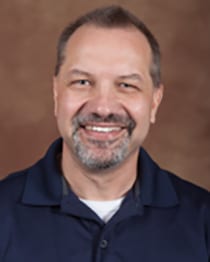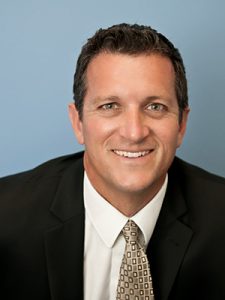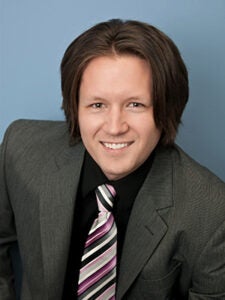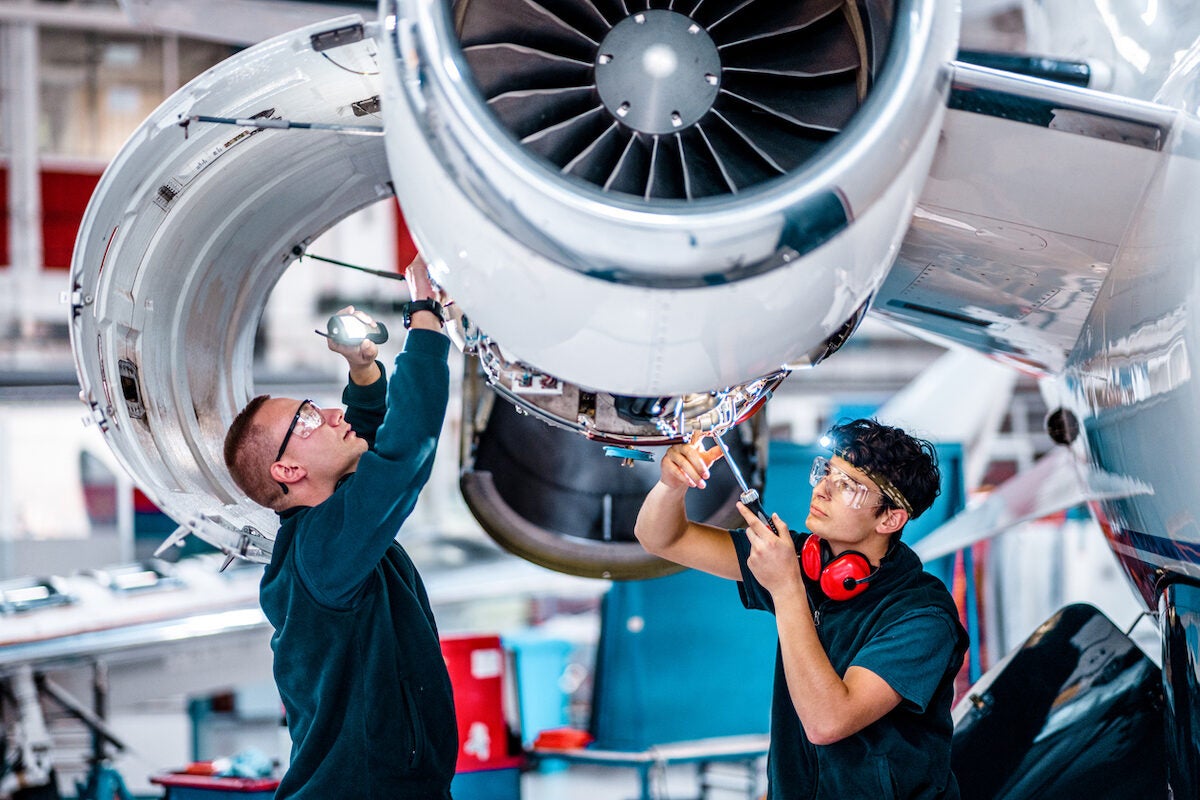The next time you see a plane flying overhead — any plane — consider this: There’s a strong possibility that a graduate or researcher from UCF had something to do with that plane being in the air. It could be an engineer who designed the propulsion system, a pilot who trained on a simulator, or a professor who developed protocols to keep the plane safe.

“The culture for producing leading-edge talent has been here for decades,” says Florian Jentsch ’97PhD, chair of UCF’s Psychology Department and director of the Team Performance Lab at the Institute for Simulation and Training (IST). “The aviation industry as a whole is better because of UCF’s roles, and employers are very much aware of that.”
A casual reader might wonder how a university with no airfield could be ranked as the nation’s No. 1 supplier of talent six times by Aviation Week Network. Or why professors in fields like psychology and digital media play such prominent roles in the advancement of that talent.
Start with Jentsch. For 30 years he’s been an integral part of one of the world’s premier programs in human factors at UCF — and what could be more important than “human factors” before and during a flight? In the same area of IST, David Metcalf and Michael Eakins ’09BA ’17MFA are creatively using multimedia to bring K-12 students into the widening aviation funnel (forecasts from Boeing indicate the industry will need more than 600,000 new pilots over the next 20 years).
“As much as I like to use new gadgets,” Eakins says, “I get the biggest charge from watching the next generation use them. When I see the lightbulbs go on for the first time, I know we’re doing something impactful.”
How UCF Fills the Talent Funnel
To trace the dots from digital media to aviation talent, let’s start with Eakins’ and Metcalf’s backgrounds. Both grew up near aerospace and aviation centers. Eakins was raised on Florida’s Space Coast, where his grandfather was part of the team that built NASA’s first lunar module. Metcalf spent his formative years near NASA’s Johnson Space Center in Houston.

“As a kid, I’d hear conversations about space and aviation,” Metcalf says. After studying computer graphics at the University of Texas, he used his multiple interests to help NASA establish its first multimedia lab. In 2006 he took another leap and launched UCF’s Mixed Emerging Technology Integration Lab (METIL) at IST. The simulation lab has since spawned innovations in dozens of fields, including mobile healthcare, mobile learning, and … here it is … aviation training.
“Our students are never bored in the lab,” Metcalf says.
Eakins was one of those students early on.
“When I started my education at UCF, I thought I’d pursue a career in gaming,” Eakins says, “but once I met David and had my first exposure to simulation, I got hooked.”
Eakins is now the creative lead of METIL, developing simulation and training tools to hook others who least expect to be hooked. The lab hosts K-12 field trips so kids can see and touch those tools.
In February 2022, Metcalf and Eakins initiated the STEM Aviation Showcase, taking headsets and tablet-based simulators to events in Central Florida. Through partnerships with Orange County Public Schools, the Boys and Girls Club, and Junior Achievement, to name a few, they’ve already made a presence at 16 events and had hands-on interactions with 1,600 curious kids.
“We’re able to bring aviation to people who have never met a pilot or maybe have never seen an airport,” Metcalf says. “The airplanes flying high over their neighborhoods might be the closest they’ve ever come to a plane. We can use the portable tools that we’ve developed in IST to cast a wider net and grow more interest among people who thought it wasn’t a reachable goal. It’s also a great way to bring more women to the front of planes.”

Most recently, Eakins developed a more advanced training aid in collaboration with Boeing. Using an AR headset and a virtual captain — an avatar designed from a real pilot — users can experience flight training without the need for a plane, an airport, or an expensive, non-portable simulator.
“Anyone who has access to this can practice flying anywhere, without any risk,” Eakins says. “It could be a gamechanger.”
The dots that lead from digital media to gaming to portable flight simulation come to a question that parents of high schoolers often ask: “What’s the next step for my son or daughter?”
“We can point out the best classes to prepare them for a career in aviation,” Metcalf says. “If they decide to come to UCF, they’ll be guided through their educational journey to the personal future they desire.”
How UCF Makes Flying Safer
Jentsch arrived at UCF in the early-mid 1990s to study for his doctoral degree in a crucial research field that, at that time, relatively few people knew anything about: human factors psychology. The application to aviation was always clear to Jentsch and his colleagues.
“The reliability of aviation is directly tied to the behavior of everyone in the system,” Jentsch says. “The gate agent. The security person. The baggage handler. The maintenance engineer. The pilot. Every person must know when to speak up and say, ‘we can’t leave the ground yet.’ Technology helps, but at the end of the day we rely on good behavior for high positive consequences — in this case, safe travel.”
In the ‘90s, UCF was one of five or six universities doing work in this space. Since then, many others have attempted to emulate UCF’s approach to research and training.
“We’re always a few steps ahead because many of our government and corporate partners are right here in Orlando,” Jentsch says. “People are always amazed that when you come into [Central Florida Research Park], you can find anyone and everyone who makes a flight simulator working here. This gives us access to tools at IST that allow us to explore the most realistic factors in aviation training.”
The control stick, however, is only as effective as the person using it. When the human factor fails, we call it “human error.” And human error is responsible for at least half of all aviation accidents.
“Our research and training in human behaviors have significantly reduced accidents since the 1980s,” Jentsch says. The Bureau of Aircraft Accidents Archives (BAAA), an organization established in Geneva in 1990 for tracking aviation safety, reported 337 accidents in 1989. By 1999, the number had dropped to 234, and in 2022 the BAAA charted 97 accidents. “You can corelate the value of those results to the value of our students in the aviation industry.”
Jentsch and his research team were among the first to trace errors back to fixable, trainable factors. Communication is a good example. They concluded that instead of trying to figure out a flurry of issues at once, it would be safer to bring each issue to a resolution before opening the next issue — closed-loop communication. The strategy has since been adopted in other industries, like medicine. The reduction in surgical errors in hospitals is partly from the implementation of checklists and briefings during nurse shift changes.
“It originated from our research for aviation,” Jentsch says. He says he’s still excited after doing this type of research for 25 years.
“What we do is meaningful, and it goes hand-in-hand with meaningful simulation training and meaningful real-world jobs, Jentsch says. “At the end of the day, when employers know that people influenced by our research can tackle any situation and make flying safer, then we’ve done our jobs well. And we don’t even need an airfield to do it.”




